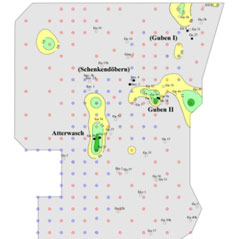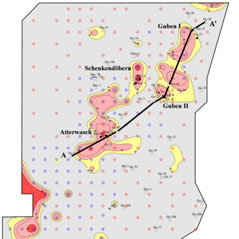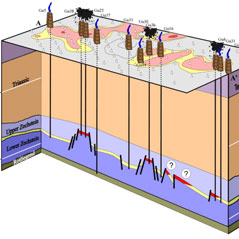Guben (Germany)
Methodology
In 1996 the MPOG® technology has been applied at the Guben region over an area of about 100 km² with an average sample interval of 1,000 m. To increase data basis, in 1997 the density of the existing sampling grid was increased to 500 m in several interesting areas. Additionally some samples were re-taken for calibration purposes. A total of 278 samples were investigated. Figures show sample stations in red (1996 samples) and blue (1997 samples). Geo-microbial results from 1997 confirm/supplement those from 1996. With the additional data, resolution of microbial anomalies identified in 1996 has been significantly increased.
Results
By extending the investigation area new anomalies were identified in the south and south-west. To the north of the "Atterwasch" field, an anomaly which was partially detected in 1996 was completely contoured in 1997. A further oil indication was detected in 1997 to the west of the "Guben II" field.
MPOG®-indications for gas and oil are displayed in the figures 1 and 2. In spite of densely located seismic profiles, exploration of small structure traps was very complicated. This is reflected in a large number of dry holes. A total of 35 dry holes has been drilled on previously detected geological traps, which are mainly located in areas without hydrocarbon indications according to the MPOG process. Some dry holes (such as Gu54, Gu 23) are located within B-type microbial anomalies, but are obviously in the margin of the fields. A statistical evaluation shows 8.3% oil indications and 7.2% gas indications from a total of 278 investigated measuring points.
The oil and gas fields of the Guben region are trapped in very small structural salt traps of fractured Ca2. The complicated geological structure along profile A-A' is shown in figure 3.
Summary
Microbial anomalies identified with MPOG® in the central and north-eastern part of the surveyed area surrounded by large areas without hydrocarbon indication. The discovered reservoirs (Atterwasch, Guben I, Guben II and Schenkendöbern) are well reflected by geo-microbial results. All production wells are located within microbial anomalies. Next to the oil and gas fields are some anomalies which have not yet been drilled, where it can be assumed that there are further small oil and gas accumulations.
In the Guben region there are oil fields with free gas caps, such as "Atterwasch" and "Guben II", as well as oil and condensate layers without gas caps, such as "Guben I" and "Schenkendöbern". This is reflected in the formation of the microbial oil and gas anomalies. The "Atterwasch" and "Guben II" fields clearly have gas indications alongside the oil indications, while no significant methane indications are recognizable above "Schenkendöbern" and "Guben I" destroyed.



